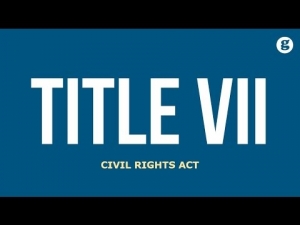Supreme Court Finds Title VII’S Requirement to File a Charge of Discrimination is not Jurisdictional
Reprinted with permission from the June 21st edition of The Legal Intelligencer. (c) 2019 ALM Media Properties. Further duplication without permission is prohibited.
In Fort Bend County v. Davis, 587 U.S. ___ (2019), the Court held that the requirement that a plaintiff in an employment discrimination case brought under Title VII, 42 U.S.C. § 2000e, et seq, file a charge of discrimination with the Equal Employment Opportunity Commission (“EEOC”) prior to filing a complaint in court is a procedural and not a jurisdiction requirement. Therefore, an employer’s failure to assert the absence of an appropriate charge of discrimination in a motion to dismiss results in a waiver of the defense. The Supreme Court’s decision resolves a split in the circuits regarding whether the requirement is jurisdictional, and highlighted the importance of the charge of discrimination and the motion to dismiss in employment discrimination cases.
Reasonable Accommodations: A Jury Verdict Provides Practical Lessons
Reprinted with permission from the April 19th edition of The Legal Intelligencer. (c) 2019 ALM Media Properties. Further duplication without permission is prohibited.
On April 12, 2019, in the United States District Court for the Western District of Pennsylvania, a jury returned a verdict that serves as a reminder to employment law practitioners of the importance of treating mental health issues with sensitivity and consistent with the Americans with Disabilities Act (“ADA”) and taking a practical approach to reasonable accommodations. The jury in Schirnhofer v. Premier Comp Solutions LLC, Western District of Pennsylvania docket number 2:16-CV-00462, found that the employer, Premier Comp Solutions LLC (“Premier”), had discriminated against the Plaintiff, Ms. Schirnhofer, on the basis of her mental health disability, and in violation of the ADA. The jury awarded Ms. Schirnhofer $285,000 in damages: $35,000 in backpay, and $250,000 in non-economic damages.
This summary of the facts of the case is drawn from the Court’s opinion on Premier’s summary judgment motion, issued on March 28, 2018. Ms. Schirnhofer began her employment at Premier in 2009, and was terminated on February 5, 2014. She was employed as a billing assistant in the billing department. During the course of her employment, she had good performance reviews. Ms. Schirnhofer was diagnosed with anxiety and other mental health issues prior to her employment with Premier. Her condition was exacerbated in 2012 when her newborn grandchild died, and a co-worker with whom she was close left Premier. What followed was a series of interpersonal problems, and conflicts with and complaints about co-workers. Premier’s president and Ms. Schirnhofer’s co-workers had referred to her as “Sybil” (referencing a character in the movie Sybil who suffered from mental health issues). The human resources representative noted that she should seek “medical attention.” Ms. Schirnhofer eventually asked for a reasonable accommodation in the form of two additional ten-minute breaks. She provided a letter from her physician regarding the need for such breaks to accommodate her Post Traumatic Stress Disorder and her Generalized Anxiety Disorder. On January 28, 2019 Premier denied the request, despite the advice of its human resources professional to provide the accommodation. Instead, Premier offered to move her work area. On a particularly bad day in February, 2014, Ms. Schirnhofer took to Facebook to vent her anxiety. She was terminated on February 5, 2014 for her Facebook posts in violation of Premier’s Social Media policy. Ms. Schirnhofer sued, alleging that Premier had terminated her in retaliation for her request for an accommodation, that Premier had discriminated against her in violation of the ADA, and that Premier had failed to provide a reasonable accommodation. The jury returned a verdict in her favor on the issue of discrimination, but found that Premier had not retaliated against Ms. Schirnhofer.
The lessons for employment law practitioners in this verdict are many, among them: mental health issues and accommodations are subtle, and require sensitivity; requests for reasonable accommodations provide an excellent opportunity for risk management; and, it is quite expensive to be wrong.
Employer's Potential Liability for Third Party Harassment
The increased attention to sexual harassment in the work place is reflected in the increasing number of sexual harassment suits filed by the United States Equal Employment Opportunity Commission-a federal agency whose responsibilities include enforcing federal nondiscrimination laws.
This trend magnifies the need for employers to be aware of an opinion by a judge of the United States District Court of the Eastern District of Pennsylvania, holding that an employer may be liable for the sexual harassment of one of its employees by a nonemployee.
In this case, Hewett v. BS Transportation of Illinois, LLC, et al., the Court considered various claims by an employee, Hewitt, including a claim of sexual harassment, against his employer, BS Transportation.
Specifically, Hewitt alleged that he was a freight driver for BS Transportation whose job responsibilities included weekly loading of oil at a Sunoco refinery.
According to the allegations in Hewitt’s complaint:
During the course of Hewitt’s employment, a Sunoco employee sexually harassed Hewitt, first with sexual
comments and hand gestures and then after Hewitt asked the employee to stop, with more aggressive behavior including
physical contact. Hewitt made complaints to the Sunoco employee’s supervisor, as well as Hewitt’s supervisor at BS
Transportation who was also the owner of BS Transportation. Although Hewitt’s supervisor indicated he would
“handle the matter” with the Sunoco employee, the supervisor did not investigate the complaint nor did the Sunoco
employee’s supervisor. After a pause in his harassment of Hewitt, Sunoco’s employee again engaged in sexual
harassment of Hewitt, who again complained to Hewitt’s supervisor. Hewitt’s supervisor did not notify Sunoco of
these latest actions by the Sunoco employee. Shortly after the resumption of the harassment, Hewitt’s employment
with BS Transportation ended.
As a result of the alleged harassment described above, Hewitt filed suit in federal court alleging, among other claims, sexual discrimination by BS Transportation in violation of Title VII of the Civil Rights Act of 1964. (The Court dismissed claims against Sunoco and its employee). While dismissing certain claims against BS Transportation and its supervisor, the Court did permit the sex discrimination claim to proceed-deeming it a claim of hostile work environment. (The Court in allowing the case to proceed did not make any factual findings regarding Hewitt’s allegation. Rather the Court needed to decide at this stage whether Hewitt stated a plausible claim against his employer).
The Court noted that the claim in this case was not like most claims of employment discrimination, where the offending conduct is alleged to have been committed by an employee of the employer. This case instead involved a nonemployee. The Court, however, allowed the case to proceed based on the allegations that a management -level employee (Hewitt’s supervisor)of BS Transportation was aware of the harassment complaints and failed to investigate or take appropriate action and that BS Transportation failed to notify Sunoco when Sunoco’s employee allegedly resumed harassment of Hewitt.
Pointing to decisions of other courts, the Court in this case held that an employer may be liable for employment discrimination “where the employer (or its agents or supervisory employees) knows or should have known of the conduct and fails to take immediate and appropriate action”(quoting Johnson-Harris v. AmQuip Cranes Rental ,LLC). The Court ruled that Hewitt had alleged sufficient facts to let the matter go forward. The Court also found that Hewitt stated a claim (yet to be proven) that BS Transportation’s supervisory employee had aided or abetted an unlawful discriminatory practice under the Pennsylvania Human Relations Act.
The obvious takeaway from this decision is that an employer must have procedures in place to immediately and thoroughly investigate claims of workplace discrimination of any type. These procedures, of course, go along with anti-discrimination policies and procedures that may be used by an employee to file a complaint with the employer.
The less obvious lesson from this case is that an employer could be found liable for the unlawful conduct of a nonemployee if it fails to take appropriate action, including a thorough investigation. The reasoning of this case can easily be applied to other nonemployees who come into contact with an employer’s employees- vendors, outside maintenance personnel, salespeople, customers and so on. An employer must be alert as to any such claim that could give rise to a lawsuit.
THE SIDE GIG AND THE FLSA: THE SIXTH CIRCUIT KEEPS UP WITH MODERN ECONOMIC REALITIES
A recent case from the United States Court of Appeals for the Sixth Circuit demonstrates the ongoing struggle to apply the Fair Labor Standards Act (“FLSA”) to the “side gigs” that have come to signify the modern employment market. In Acosta v. Off Duty Police Services, Inc., United States Court of Appeals for the Sixth Circuit, Nos. 17-5995/6071 (February 12, 2019), the Sixth Circuit held that security offers working for Off Duty Police Services (“ODPS”) as a side job were employees entitled to overtime pay under the FLSA.
ODPS workers were either sworn law enforcement officers who worked for law enforcement entities during the day, or unsworn workers with no background in law enforcement. All workers had the same duties, but sworn officers earned a higher hourly rate. Duties included “sitting in a car with the lights flashing or directing traffic around a construction zone.” They were free to accept or reject assignments, but would be punished by withholding future assignments if they did so. When they accepted an assignment, ODPS instructed the workers where to report, when to show up, and who to report to upon arrival. ODPS provided some equipment, but workers did have to use some of their own equipment. Workers followed customer instructions while on assignment, and only occasionally received supervision from ODPS. ODPS paid workers for their hours upon submission of an invoice. Workers did not have specialized skills, as sworn officers and unsworn workers had the same duties.
ODPS treated the workers as “independent contractors.” As the facts set forth in the Sixth Circuit opinion demonstrate, the factors relevant to determining whether a worker is an independent contractor or employee do not provide a clear answer. The United States District Court for the Western District of Kentucky broke the tie this way: the court held that “nonsworn workers” were employees, but that the sworn officers were independent contractors because they “were not economically dependent on ODPS and instead used ODPS to supplement their incomes.”
The Sixth Circuit disagreed, noting that the FLSA is a broadly remedial and humanitarian statute, designed to improve labor conditions. The Sixth Circuit applied the “economic reality” test to determine that the sworn offers were also employees and not independent contractors, and to uphold the finding that unsworn workers were employees. Specifically, the Court noted that the officers provided services that represented an integral part of the business, and that the work required no specialized skills, that the officers made only limited investment in equipment, and that the workers had little opportunity for profit or loss. The Court noted that the facts did not “break cleanly in favor of employee or independent contractor status” regarding the right to control the work for the sworn officers.
Navigating Noncompetes Part III: Employees, the Restricted Parties
In the last segment of this series, we focused on concerns for employers in drafting and enforcing restrictive covenants. The choices for employees are fewer, and none of them are good. Employees are generally asked to sign restrictive covenants at two points: either at the beginning of their career or upon a promotion or other significant improvement in employment status. Such agreements diminish employees’ choices should they want to move on from their current employment, whether or not the restrictions are actually enforceable.
Some employers require employees to sign a restrictive covenant at the outset of their employment. If the employee was recruited and has other employment choices, the employee has some bargaining power to reduce the duration or scope of the restrictions. But this is seldom the case, and the law recognizes that employees generally have limited (or no) bargaining power in these situations. The law disfavors restrictive covenants for precisely this reason: the agreement imposes a post-employment restriction that may hinder the employee’s ability to earn a living at a time when the employee has little or no bargaining power to negotiate the restriction.
This calculus changes a little when the employee is required to sign a restrictive covenant in conjunction with a promotion or other benefit, such as participation in a stock option or bonus program. Then the employee has to decide whether the value of the promotion or other benefit is enough to justify agreeing to the post-employment restriction. Where it is not, the employee can refuse to sign, forcing the employer to decide how valuable this employee is to the employer. However, the employee should factor into this decision that the employer is free to terminate the employee for refusing to sign. And, this might be a good thing, as the employee will be leaving the employer without a noncompete.
Frequently, employees breach the restriction without consulting an attorney first based on the widely held, mistaken, belief that courts do not enforce noncompetes. Let’s be clear: courts will enforce noncompetes where the law permits them to do so. More importantly, the old employer will sue the employee and the employee’s new employer for breach of the agreement. The new employer may terminate the new employment to avoid the costs of litigation. Litigation regarding these matters is expensive, time-consuming and stressful. Practically speaking, most employers will refuse to hire an employee with a restrictive covenant even if it is unenforceable for any number of technical reasons we have discussed in this series.
At the very least, employees should consult an attorney prior to signing, even if they have limited bargaining power, to understand the restrictions in place. We can help employees with that review, and we can help employees navigate the minefield of finding new employment when they have a noncompete in place.
Employers------Protect Your Employees’ Data - Or Else!
The Pennsylvania Supreme Court has recently held that an employer may be liable to its employees for a data breach involving the employees’ “personal and financial information including names, birth dates, social security numbers, addresses, tax forms and bank account information…”
The case, Dittman v. UPMC d/b/a The University of Pittsburgh Medical Center and UPMC McKeesport (“UPMC”), involved a class action complaint on behalf of 62,000 current and former employees of UPMC. The employees asserted that their personal and financial information (described above) was stolen from UPMC’s computer systems and “used to file fraudulent tax returns on behalf of the victimized [e]mployees, resulting in actual damages”. Significantly, the employees also asserted that the information accessed and stolen was information they were required to provide their employer as a condition of employment.
The employees’ claims against UPMC were based on their employer’s alleged negligence in failing to properly maintain and protect the employees’ personal and financial information. Two lower courts had ruled against the employees, resulting in a dismissal of their claims.
On appeal, the Pennsylvania Supreme Court reversed the lower courts and concluded that an employer has a legal duty to exercise reasonable care in collecting, storing and safeguarding its employees’ personal and financial information where the employer chooses to store such information on an “internet accessible computer system” and the employees are required to provide such information as a condition of employment.
Based on the Court’s recognition of this duty, the issue in the case then turned on the question as to whether the UPMC could be said to have been negligent in the performance of its duty to its employees. As with any matter, where one party is claiming injury because of another party’s negligence, the ultimate outcome is fact- specific. In this case, the Court held that the employees had stated a potential claim where they asserted that their information was negligently “collected and stored on its [employer’s] internet-accessible computer system without the use of adequate security measures, including proper encryption, adequate firewalls and an adequate authentication protocol.”
The Court did not accept UPMC’s defense that the data breach occurred as result of criminal activity rather that UPMC’s own negligence: the criminal activity would be “ ’within the scope of risk created’ “ by UPMC and thus something against which it would have to provide protection.
Also rejected by the Supreme Court, was the lower courts’ application of the economic loss doctrine. This doctrine, as interpreted by the lower courts, would have barred the employees’ claims because they alleged no physical injury or property damage-only an economic loss. The Supreme Court held that this doctrine was not applicable to the claims in this case because the employees’ claims were not based on a contract claim but based on a tort, namely the alleged negligence of the UPMC in undertaking its duty to protect the employees’ information.
The Supreme Court, having set forth the employer’s duty to its employees, sent the case back to the trial court for new proceedings consistent with the Supreme Court’s ruling. (The Supreme Court did not actually make a factual determination by this case that the employer was negligent).
The decision in this case should cause an employer to triple-check the safeguards attached to the data it maintains and to further consider what personal data and financial data(if any) of its employees the employer actually needs to retain. Any data breach may be litigated and analyzed against what protections were in place, what protections could have been in place and whether the employer used reasonable care to protect the information.
Navigating Noncompetes Part II: What Employers Should Consider
Part 2 of our Noncompete Series will focus on employers. Noncompetes, when well drafted, are a powerful tool to protect customer relationships, confidential information, trade and training secrets, and key employee relationships. But, the law does not favor these agreements, so drafting requires care, and, as a practical matter, timing is everything.
While noncompetes are disfavored and maligned, they do serve useful purposes for certain employers. There are two types of restrictions that such agreements can impose: general prohibits on certain kinds of competition; or, prohibitions on soliciting customers, vendors, employees, contractors, or other valuable relationships. For the most part, restrictions on soliciting customers, employees and other key relationships are easier to enforce. They allow the employee to continue to work, and protect those relationships for the employer. For some employers, these restrictions, tailored to their business and in place for a sufficient period of time, are enough. Generally, these restrictions tend to last a year or perhaps two. Employers will need to weigh the dangers of making the restriction too long, and thus unenforceable, as against the time it takes for those relationships to go stale.
Restrictions on competition generally are another matter. The general principle applied by the court is this: a court will not enforce the restriction if it is not designed to protect a legally recognized protectable interest, renders an employee unable to pursue his chosen profession, or appears designed to eliminate fair competition. The court will only act to protect the following interests: trade secrets or confidential information, specialized training the employee received from the employer, or customer good will developed using the employer’s resources. Given these competing factors, it is best to narrowly tailor the restriction to the employer’s business. An employee is more likely to comply with such a restriction (thus avoiding court), and a court is more likely to enforce it as written.
Employers next must consider when to ask employees to sign noncompetes. These agreements are enforceable when signed at the beginning of the employment relationship. A noncompete executed by an employee after the employee has worked for the employer for a period of time is not enforceable unless accompanied by a raise or promotion, or some other benefit. This creates a practice problem for employers. Often, a noncompete is not required at the beginning of employment, but circumstances change: employees are promoted, the nature of the business changes, the employer becomes more sophisticated about its internal procedures, for example. A skilled employee with options in the marketplace may very well refuse to sign such a restriction where the new consideration offered is simply not worth it. So, for example, while a bonus of $500 is enough to make the agreement legally enforceable, it may also not be enough to cause the employee to sign. This creates a difficult situation for the employer – should the employer terminate and lose the key employee, or allow the employee to stay without a noncompete?
Creating a noncompete program for employees is complex, and many of the issue are interrelated. In addition to the legal concerns, employers must consider what concerns and relationships truly require protection, as well as retention and morale issues. We have helped many employers sort through these issues and are uniquely equipped to help businesses navigate difficult noncompete issues.
The third installment of my Navigating Noncompetes series will look at noncompetes from the employee's perspective, outlining potential issues which should be considered before signing such an agreement.
NAVIGATING NONCOMPETES PART 1: THE BASICS
A recent Washington Post article proclaimed that “even janitors have noncompetes now.” New Jersey and Pennsylvania are considering legislation to regulate the terms and enforceability of documents that restrict employees’ ability to compete with their former employees. "Noncompete Litigation Lessons from the 10th Circuit". These restrictions require discussion and attention: they impact the economy, employee mobility, and the trade secrets and good will of businesses. In the coming weeks, we will explore issues relating to noncompetes in order to shed some light on this complex employment law topic, and offer guidance to both employers and employees grappling with the potential risks and consequences of missteps in these agreements.
This week, let’s start with the basics.
Pennsylvania law recognizes that an agreement that restricts the ability to compete is a restraint on trade, and courts should construe them narrowly. Such agreements are only permitted in two contexts: where they are ancillary to the employer – employee relationship (including independent contractor relationships), or where they are ancillary to the sale of a business. The restriction must be reasonable in terms of scope, geography and time. A court will review whether the restriction in the agreement is narrowly tailored to address certain legally protectable interest, such as good will, trade secrets or specialized training.
Such agreements, as with all contracts, must be accompanied by consideration. In the context of employment-related noncompetes, continued employment will not suffice. Instead, the noncompete must be executed at the beginning of the employment relationship, or, if signed during the employment relationship, accompanied by additional consideration such as a promotion, raise or bonus.
Noncompetes come in many forms: restrictions on working for competitors or setting up a competing business; restrictions on soliciting or accepting work from customers, clients, vendors or suppliers; restrictions on working as an employee for a customer, client, vendor or supplier; and restrictions on soliciting employees away from the employer. Limitations on solicitation are generally more enforceable than blanket restrictions on competition. Some noncompetes are accompanied by a period of severance pay, commonly referred to as “garden leave”. Some agreements include provisions for the employer to release an employee from a noncompete under certain conditions.
When an employee breaches a noncompete, the employer has a powerful weapon to enforce the document: the employer can request an emergency order from the court prohibiting the employee, and even the employee’s new employer, from engaging in activity in breach of the agreement. The court proceeding that results in the emergency order, called a preliminary injunction, usually occurs quickly, and such litigation is expensive and stressful. Often, noncompete agreements have provisions that require the employee to pay the employer’s legal fees in the event of a breach. A court is free to “blue pencil” the noncompete. This means that the court can rewrite the restrictions in a manner that is reasonable and consistent with the employer’s legally recognized protectable interests.
In the next installment of my Navigating Noncompetes series, you will see how to apply some of these basics to examine the issues that employers should consider in drafting and enforcing noncompetes.
NONCOMPETE LITIGATION LESSONS FROM THE TENTH CIRCUIT
Reprinted with permission from the August 18th, 2018 issue of The Legal Intelligencer. (c) 2018 ALM Media Properties. Further duplication without permission is prohibited.
A recent case from the United States District Court for the Tenth Circuit, First American Title Insurance Company, et al. v. Northwest Title Insurance Agency, et al., no. 17-4086, illustrates nicely the complicated issues faced in noncompete litigation, and the risks a good agreement can prevent. Although the case arose in the United States District Court for the District of Utah, the issues confronted and legal principles cited arise frequently under Pennsylvania law.
The individual defendants were employed by First American Title Insurance Company, and had signed various restrictive covenants of one year in duration. All individual defendants were subject to a code of ethics and employee handbook that required employees to use office equipment for company business only, and barred outside activity competing with First American. First American Title Company acquired the stock of First American Title Insurance Company pursuant to a Stock Purchase Agreement. Defendant Smith created defendant Northwest Title Insurance Company, and then quit his job with First American. The day after Smith resigned defendants Carrell and Williams resigned and all individual defendants took positions at Northwest Title Insurance Company, along with twenty-five other employees over the next two weeks. Litigation ensued, and defendants suffered a large jury award at trial.
Lesson 1: File petitions for preliminary injunction early, and make sure to have a tolling provision in the agreement.
The First American District Court denied the plaintiff’s motion for a preliminary injunction after a hearing, finding that there was no irreparable harm. Notably, the individual defendants resigned in March of 2015, and their restrictive covenants, which did not contain tolling provisions, terminated in March of 2016. Plaintiffs filed the petition for preliminary injunction in January of 2016, with only two months remaining on the restrictive covenants, and the motion was not heard until September 2016. The case then proceeded to a trial, resulting in the appeal addressed by the Tenth Circuit. An injunctive order entered early in a case tends to change the dynamic of a case going forward, providing opportunities for sanctions and contempt motions, and an incentive to settlement. Certainly, defendants enjoyed an early victory that rendered this case solely about damages. Indeed, this may well have been the strategy: part of the court’s reasoning on the preliminary injunction was that most of the damage had already been done, in light of the quick transfer of customers and employees.
A preliminary injunction is only powerful when filed early, and it might be worth considering foregoing the motion in certain circumstances, where the tactical advantages of early filing are lost. Most importantly, a tolling provision in the document might have changed the outcome: drafters must include a provision that extends the duration of the restrictive covenant where the employee is in breach.
PENNSYLVANIA’S PROPOSED RULEMAKING UNDER THE PENNSYLVANIA MINIMUM WAGE ACT
PENNSYLVANIA’S PROPOSED RULEMAKING UNDER THE PENNSYLVANIA MINIMUM WAGE ACT
Reprinted with permission from the August 18th, 2018 issue of The Legal Intelligencer. (c) 2018 ALM Media Properties. Further duplication without permission is prohibited.
In 2016, the United States Department of Labor proposed changes to regulations regarding exemptions from the overtime and minimum wage requirements of the Fair Labor Standards Act (“FLSA”). The proposed changes nearly doubled the salary requirement to qualify for these exemptions. Employers hurried to change policies and reclassify employees in order to meet the December 31, 2016 deadline to comply with the new salary requirement. In late 2016, a federal court imposed an injunction on the imposition of those rules, and there the new regulations died (more at the hands of the Trump administration than as a result of legal challenges). Among other observations, the federal district court for the Eastern District of Texas concluded that the injunction was necessary because the new salary requirement was so high that it rendered the duties test “irrelevant.”
The proposed change was dramatic, and would have required significant policy and personnel changes. Now, Pennsylvania is taking on those salary requirements in a less dramatic, but no less significant way.






























